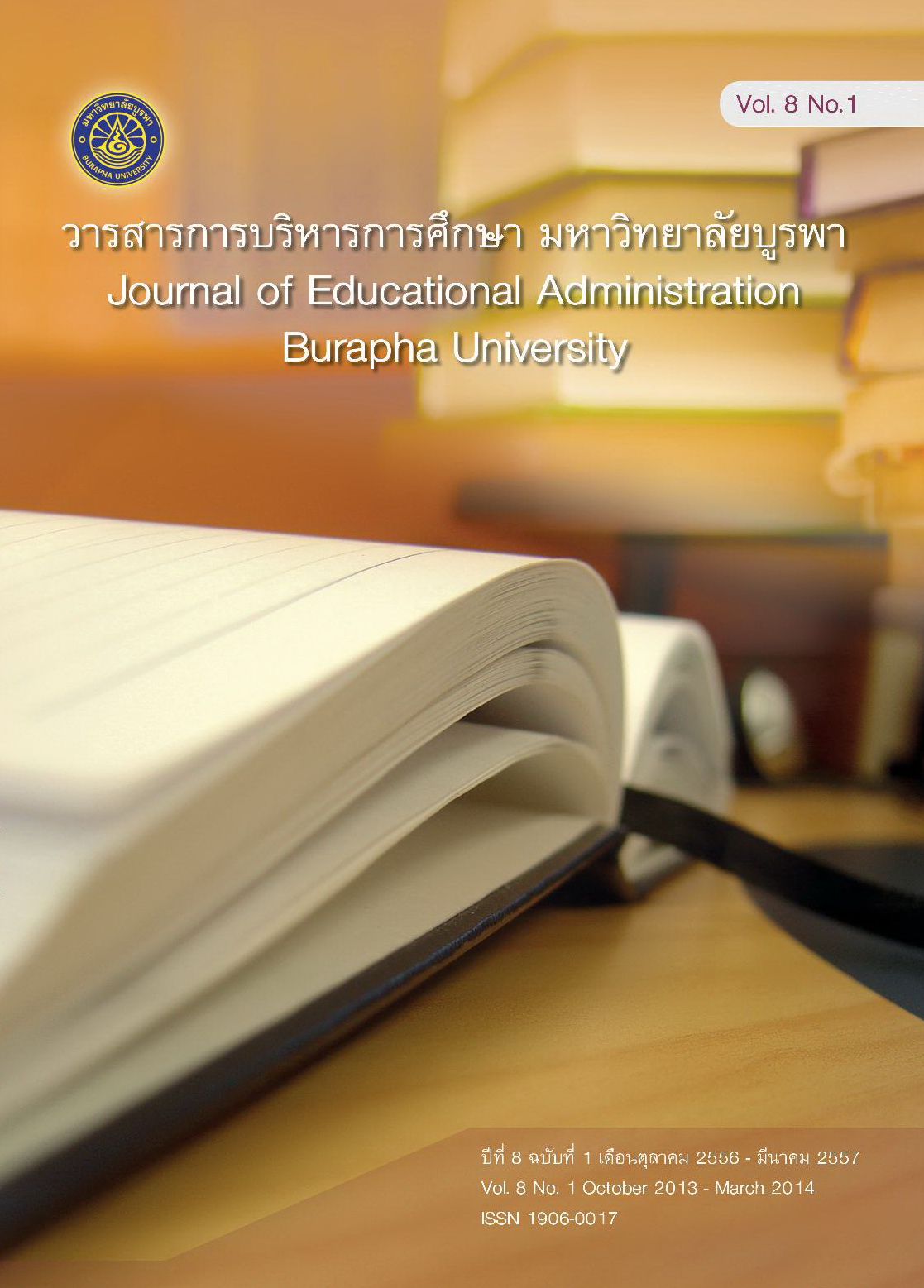รูปแบบการพัฒนาครูผู้สอนกลุ่มสาระวิทยาศาสตร์โรงเรียนประถมศึกษา : กรณีศึกษาโรงเรียนบ้านมะขาม (สาครมะขามราษฎร์) จังหวัดจันทบุรี (MODEL OF SCIENCE TEACHERS DEVELOPMENT IN PRIMARY SCHOOL: BANMAKHAM SCHOOL AS A CASE STUDY)
Keywords:
รูปแบบการพัฒนาครูผู้สอนกลุ่มสาระวิทยาศาสตร์, โรงเรียนประถมศึกษา,Abstract
บทคัดย่อ
การวิจัยครั้งนี้ มีวัตถุประสงค์เพื่อพัฒนารูปแบบการพัฒนาครูและเพื่อกำหนดกรอบของกระบวนการ และเกณฑ์การพัฒนาครูผู้สอนกลุ่มสาระวิทยาศาสตร์โรงเรียนประถมศึกษา โดยกำหนดใช้เทคนิควิธีวิจัยตามกระบวนการวิจัยเชิงปฏิบัติการแบบมีส่วนร่วม ผู้ให้ข้อมูลหลักได้มาจากการสุ่มแบบเจาะจง ประกอบด้วย รองผู้อำนวยการโรงเรียนและครูผู้สอน จำนวน 13 คน ของโรงเรียนบ้านมะขาม จังหวัดจันทบุรี เก็บข้อมูลด้วยการศึกษาเอกสาร การสัมภาษณ์และการสังเกตแบบมีส่วนร่วม และใช้การวิเคราะห์เชิงปรากฏการณ์วิทยาในการวิเคราะห์ข้อมูล
ผลการวิจัยพบว่า
1. รูปแบบการพัฒนาครูผู้สอนกลุ่มสาระวิทยาศาสตร์โรงเรียนประถมศึกษา ประกอบด้วย 1) กำหนดเป้าหมายร่วมกันของครู ผู้ปกครอง และผู้เกี่ยวข้อง 2) กำหนดกิจกรรมพัฒนาครูผู้สอนวิทยาศาสตร์เป็นการกำหนดมาตรฐาน กำหนดศักยภาพสถานศึกษาและการวิจัยเชิงปฏิบัติการ 3) การกำหนดหลักเกณฑ์การพัฒนา เป็นการพัฒนาทีมงานของครู การพัฒนาแหล่งเรียนรู้ภายใน – ภายนอกโรงเรียน การพัฒนาวิชาชีพครูผู้สอน การจัดกิจกรรมการเรียนการสอนและการวิจัยเชิงปฏิบัติการ 4) พัฒนาครูตามกระบวนการ PAOR 3 รอบ และ 5) การประเมินผลตามวัตถุประสงค์การวิจัย
2. กระบวนการพัฒนา กิจกรรมการพัฒนาและเกณฑ์การพัฒนาครูผู้สอนกลุ่มสาระวิทยาศาสตร์โรงเรียนประถมศึกษา มี 5 กระบวนการคือ 1) การพัฒนาทีมงาน ประกอบด้วย การสร้างทีมงานนันทนาการ การออกกำลังกาย การดูแลซึ่งกันและกัน การแลกเปลี่ยนเรียนรู้ การผลิตสื่อ ประเมินผ่านเกณฑ์การพัฒนา ร้อยละ 85-100 2) การกำหนดแหล่งเรียนรู้ภายในและภายนอกโรงเรียน ประกอบด้วย การอบรมเชิงปฏิบัติการจัดทำหน่วยการเรียนรู้ จัดทำแผนการเรียนรู้ การใช้แหล่งเรียนรู้ ประเมินผ่านเกณฑ์การพัฒนาร้อยละ 80-100 3) การพัฒนาวิชาชีพ ประกอบด้วย การอบรมปรัชญาและทฤษฎีการสอน การใช้เทคโนโลยีวิทยาศาสตร์ จัดทำคู่มือการใช้อุปกรณ์และสื่อ และการผลิตสื่อการสอน ประเมินผ่านเกณฑ์การพัฒนาร้อยละ 80-100 4) การจัดกิจกรรมการเรียนการสอน ประกอบด้วย การสังเกตการสอนในชั้นเรียน อบรมเทคนิคการสอน ประชุมเชิงปฏิบัติการจัดทำแผนการเรียนรู้ศึกษาดูงานการสอน ประเมินผ่านเกณฑ์การพัฒนาร้อยละ 80-100 5) การวิจัยเชิงปฏิบัติการประกอบด้วย ศึกษางานวิจัยที่เกี่ยวข้อง แลกเปลี่ยนเรียนรู้การทำวิจัยในชั้นเรียน จัดทำโครงการวิจัยในชั้นเรียน และการใช้เทคโนโลยีเสนอผลงานวิจัย ประเมินผ่านเกณฑ์การพัฒนาร้อยละ 90-100
ABSTRACT
The purpose of this study was to develop a model for science teacher development in primary school by using A-I-C technique and participatory action research process. There were thirteen (13) major informants of this study consisting of deputy school director, school director and teachers from Banmakham School who were purposive selected. Data were collected by document analysis, in-depth interview and participatory observation. The phenomenological analysis was also used to analyze the collected data.
The study revealed that
1. The model of science teacher development in primary school was composed of: 1) Collaborating goal setting between teachers, parents, and stakeholders. 2) Setting activities of science teacher development program which were; setting of teaching criteria, setting of school abilities and setting of action research criteria. 3) Setting of developmental criteria which were; teacher team work development, development of learning resources both inside and outside school, teaching professional development, teaching-learning activities and action research development. 4) Teacher development through PAOR process for 3 rounds and 5) Results evaluation.
2. Process activities and criteria of Science teacher development in primary school were 5 steps of 1) Team work development consisted of; performing recreation teams, exercise, caring among group members, sharing information of teaching, producing teaching tools. The results of these development activities were passed at 85-100 percent. 2) Learning resources both inside and outside school consisted of; workshop of learning units, writing lesson plan, applying learning resources of classes. The results of these activities were passed at 80-100 percent 3) Professional development consisted of; providing the knowledge of philosophy and learning theories, using science technologies and using the manual and teaching tools provided. The results of these activities were passed at 80-100 percent 4) Performing teaching–learning activities consisted of; classroom observation, training of teaching techniques, workshop for lesson plan writing, and study tour. The results of these activities were passed at 80-100 percent. 5) Action research consisted of; concerned research study, sharing information about classroom action research, as well as technology for research presentation. The results of these activities were passed at 90-100 percent.


